Industries across the board, in today’s world of data, rely on artificial intelligence (AI), and machine learning (ML) for gaining valuable insights out of vast amounts of data. An image annotation technique is a key computer imaging technique that plays a crucial role in making visual data understandable. This article explores the world image annotating and the importance of tools for annotating images, software and solutions for unlocking the power of data-driven decisions.

Image annotation is the method of labeling images and tagging them with metadata. This helps computers understand and comprehend visual information more accurately. By adding annotations like bounding boxes or polygons, keypoints or semantic segmentation annotation allows ML models to identify patterns, objects, as well as attributes contained in images. This method can bridge the gap between raw data from images and actionable insights, paving the way for applications across a variety of domains, including autonomous vehicles medical imaging, e-commerce, as well as surveillance systems.
A wide range of image annotating tools has been developed to facilitate annotation. These tools have intuitive interfaces that let users easily mark objects or images that are of interest. The tools come with a broad array of annotation options and options for customization to meet different requirements for data. An image annotation tool is offered in a variety of options, including basic drawing tools, advanced shape recognition, and automatic annotation suggestions. Annotators have the capability to work quickly and with precision.
Image annotation solution takes the annotation process to the next level by incorporating automation and collaboration features. These software solutions leverage ML algorithms to automate the process of annotation, decreasing manual labor and increasing the speed of annotation. The software for annotation uses techniques like active learning and transfers knowledge to speed up the process of labeling, while also ensuring high-quality results.
Annotation software can also facilitate collaboration between multiple annotators. This allows teams to work seamlessly together. It provides real-time synchronization, annotation versioning and commenting functionalities, ensuring smooth communication as well as fostering a cooperative environment. This collaborative approach not only improves annotation quality and facilitates sharing knowledge and ensures an even distribution of annotations.
When choosing an image annotation system, several factors need to be taken into consideration. The software must be able to meet the requirements of your project. This includes the kinds of annotations required (e.g. bounding boxes or keypoints, polygons), as well as the degree of complexity and scalability.
The second is the flexibility of the solution is vital. An efficient solution for annotation must permit modifications to workflows that are used for annotation and also integration with existing systems as well as compatibility with multiple data formats. This flexibility ensures that the annotation tool can seamlessly integrate with existing pipelines and workflows which will increase overall efficiency.
The third factor is the quality of the annotations generated by the application should be evaluated. To ensure consistency and accuracy the most reliable image annotation software utilize quality control systems. These can be used to ensure annotation validation and feedback loops that are continuous between the annotators.
The significance of images annotating goes beyond the annotation process. An image annotation tool, solution, and software can help businesses maximize the value of their data through a variety of ways. Most importantly, accurate annotations can be used to aid in the development and training of ML models with better quality and accuracy. These models can be used for various applications like image classification, object recognition, and anomaly detection.
Annotation of images can be utilized to aid in making data-driven decisions by providing valuable and extensive insights. In the medical field, medical images annotated with annotations can help diagnose ailments, spot abnormalities or plan treatments. Images are often used to make annotations in e-commerce to support the search function of images such as visual merchandising system for recommending products.
In unlocking this powerful asset, the use of annotations of images with data science has transformed the way we work. It speeds up the analysis of data, exposes hidden relationships and provides real-time information. Through image annotation, businesses can streamline their processes, go to market faster, decrease costs and gain an competitive advantage. Annotated images are more readable and valuable for all the stakeholders within any organization since they are able to visualize concepts more easily than abstract images. In the end, if used correctly, image annotation is a powerful tool for transforming data into actionable information and maximising its value in all kinds of applications.